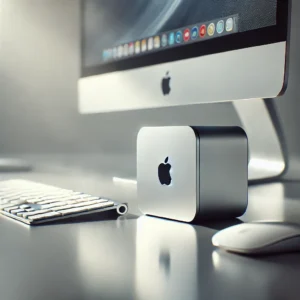The M4 Pro and M4 Max chips mark a significant leap forward in Apple’s custom silicon journey. Built using advanced 3-nanometer technology, these chips offer a tighter and more efficient design, allowing more transistors to fit in a smaller space. This results in improved power efficiency, higher speed, and a compact architecture that makes the MacBook Pro even more powerful without sacrificing battery life.
- Enhanced CPU and GPU Performance:
The M4 Pro boasts a 12-core CPU and a 32-core GPU, while the M4 Max pushes the limits with a 16-core CPU and up to a 48-core GPU. This translates to faster rendering times, smoother multitasking, and a level of graphical performance previously unseen in the MacBook Pro lineup. - Unified Memory Architecture:
Both chips are equipped with Apple’s Unified Memory Architecture, enabling the CPU, GPU, and neural engine to access memory seamlessly. This architecture reduces latency, speeds up processing, and enhances memory efficiency. - Energy Efficiency:
Thanks to the 3nm manufacturing process, both M4 chips are designed to be more power-efficient than their predecessors. This efficiency is especially valuable for users who rely on their MacBook Pro for prolonged, intensive tasks such as video editing, 3D rendering, and data analysis.

The M4 Pro and M4 Max represent the pinnacle of Apple’s in-house chip development, solidifying the MacBook Pro’s position as a top choice for professionals seeking cutting-edge performance.
Section 2: Benchmarking the Performance
The performance enhancements brought by the M4 Pro and M4 Max chips can be quantified through a variety of benchmark tests that assess speed, multitasking capabilities, and processing power.
- Geekbench Scores:
Early Geekbench scores show the M4 Pro and M4 Max outperforming previous M-series chips by a significant margin. For instance, single-core performance sees a boost of up to 20%, while multi-core performance gains exceed 30%. This means faster boot times, speedier application launches, and overall smoother operation. - Real-World Use Cases:
For video editors, rendering times on software like Final Cut Pro and Adobe Premiere Pro are drastically reduced, with users reporting up to 40% faster exports compared to the M3 models. Developers and programmers benefit from reduced compilation times, allowing for quicker testing and deployment of projects. Game developers and 3D modelers will especially appreciate the high-speed rendering and real-time feedback made possible by the increased GPU cores. - Thermal Management:
Despite the added power, Apple has managed to improve the thermal efficiency of the MacBook Pro. With advanced cooling systems, the laptop remains cool even under heavy workloads, ensuring that performance isn’t throttled due to overheating.
With the M4 Pro and M4 Max, Apple has delivered a machine that can handle anything thrown its way, whether it’s high-level creative work or intensive computational tasks.
Section 3: A Design Fit for the Future
While the MacBook Pro retains its iconic design, the latest models introduce subtle but meaningful improvements that enhance user experience.
- Lighter and Slimmer Build:
Despite the addition of a more powerful chip, Apple has managed to make the new MacBook Pro slightly lighter and slimmer than its predecessor. This makes it easier to carry around without compromising on power. - High-Resolution Mini-LED Display:
The MacBook Pro’s screen remains one of the best in the industry. Equipped with a mini-LED display, the laptop offers higher contrast ratios, deeper blacks, and brighter colors. The 120Hz ProMotion technology further ensures smooth scrolling, especially beneficial for video editors and digital artists. - Enhanced Audio and Webcam Quality:
Apple has updated the audio system with better speakers and improved sound quality. The new 1080p FaceTime camera delivers clearer video, especially in low-light conditions, making it perfect for video conferencing and content creation.
Apple’s attention to detail ensures that each feature, from the display to the sound quality, adds value to the user experience.
Section 4: Battery Life and Efficiency
With the M4 Pro and M4 Max, Apple promises extended battery life, which remains one of the biggest draws of the MacBook Pro. The increased power efficiency of the M4 series ensures that users can run demanding applications for hours without needing to recharge.
- All-Day Battery Life:
Under standard usage, the new MacBook Pro can last up to 20 hours on a single charge, making it ideal for professionals on the go. For heavy users running applications like Final Cut Pro, the battery still performs exceptionally well, outlasting many other high-performance laptops. - Eco-Friendly Components:
Apple has incorporated recycled aluminum and rare earth materials in the MacBook Pro, continuing its commitment to environmental sustainability. The M4 chips themselves are designed to consume less power, contributing to a lower carbon footprint without sacrificing power.

Section 5: Pricing, Availability, and Market Position
The MacBook Pro with M4 Pro and M4 Max is positioned as a high-end product, priced to reflect its premium features. Pricing starts at $2,499 for the M4 Pro model, with additional costs for higher configurations, such as increased RAM and storage.
- Target Market:
The MacBook Pro is aimed squarely at professionals who need serious computing power on the go. Content creators, software developers, and other tech professionals will find value in the processing capabilities and high-end features, making it an investment that’s likely to pay off through enhanced productivity. - Availability and Configurations:
The new models are available through Apple’s online store and select retail outlets. Customers can configure their MacBook Pro with up to 64GB of unified memory and up to 8TB of storage, offering flexibility for users with different needs.
Apple’s commitment to quality and innovation makes the MacBook Pro a leading choice for those who prioritize both power and design in their laptops.











